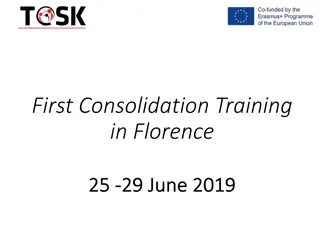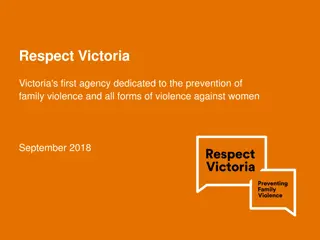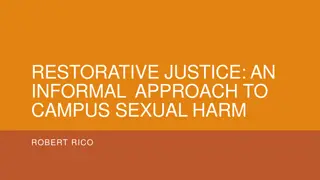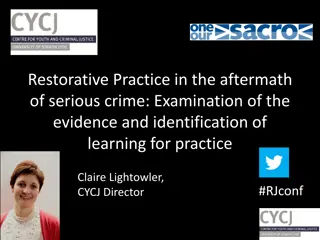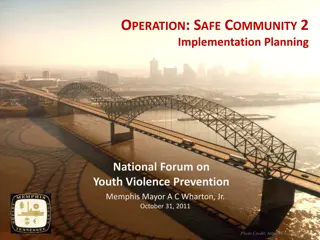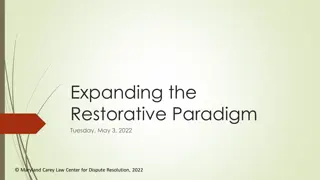Campus Violence Prevention and Restorative Justice in Education Forum
This article explores the origins and factors contributing to violence in society, particularly on university campuses. It discusses the importance of restorative justice practices in resolving conflicts and promoting accountability among students. By encouraging dialogue, accountability, and community service, universities can build a culture of peace and prevent campus violence effectively.
Download Presentation

Please find below an Image/Link to download the presentation.
The content on the website is provided AS IS for your information and personal use only. It may not be sold, licensed, or shared on other websites without obtaining consent from the author.If you encounter any issues during the download, it is possible that the publisher has removed the file from their server.
You are allowed to download the files provided on this website for personal or commercial use, subject to the condition that they are used lawfully. All files are the property of their respective owners.
The content on the website is provided AS IS for your information and personal use only. It may not be sold, licensed, or shared on other websites without obtaining consent from the author.
E N D
Presentation Transcript
Campus violence prevention and student accountability: perspectives from indaba dialogic forum, restorative justice and peace education JEAN CHRYSOSTOME KIYALA KIMBUKU, PHD. HONORARY RESEARCH ASSOCIATE AT THE INTERNATIONAL CENTRE OF NONVIOLENCE (ICON) DURBAN UNIVERSITY OF TECHNOLOGY ML SULTAN CAMPUS, DURBAN, SOUTH AFRICA
Why there is violence in society? For Schirch (2004), inter-human violence originates from choices regarding What they decide to consume How they interact with one another When they deem the use of force against others as necessary to satisfy their needs For World Health Organization, violence = the pursuit of individuals unfettered whims at the expense of others rights EGO AND SELFISHNESS
Factors Consequences Substance abuse Low self- esteem Excessive alcohol consumption Depression Inability to self- regulation Anger/bitterness Retaliation, etc. Drop-outs, etc.
RJ AS STUDENTS ACCONUNTABILITY REVOLUTION For David Karp (2004), Increasing incidents of campus violence raise the question about the effectiveness of punitive sanctions in making campus colleges safer spaces.
RJ Praxis Restorative justice encourages dialogue among victims and offenders to construct plans of action that hold offenders accountable and meet victims needs. Restorative processes help educate community members about the need for civic commitment, and build student capacity for evaluating the impact of their behavior on the community (Karp, D., & Conrad, S. (2005, p. 317)
Campus Peacebuilding strategies Restorative justice (RJ) Indaba (never investigated ) Peace education Universities around the world are moving towards restorative justice approaches in tackling violence (Rinker and Jonason 2014, Wilson 2006) RJ sanctions: apology, restitution and enlightened community service (Karp, D. & Conrad, S. 2005)
Indaba Dialogic Institution Indaba is proposed as a viable model of conflict transformation and problem-solving on campus. Part of African long tradition of conflict resolution Rooted in a communitarian conception of the human person In pre-colonial Africa, justice was handled by the council of elders humanistic and
Variations In Indaba Functionality Indaba = indigenous jurisprudence a non-adjudicative dispute institution, and it has also incentivized the framework of the KwaZulu-Natal Bill of Rights, as noted by Hund (1989) It serves as legal framework in which various social groups and individual rights are recognized respect of what inspires values, in both the Western and (Hund 1989). Based on Ubuntu and African Palaver resolution in absolute African worldview
Indaba and Ubuntu Ubuntu implies a humanistic spirit which inspires reconciliation (Nabudere 2005), instead of retaliation for the harm/hurt. Ubuntu underlies the notion of human rights and dignity (Metz 2011), Ubuntu sets the ground for restorative justice praxis instead (Gade 2013, Louw 2008). Ubuntu is prioritized during Indaba for peaceful dispute attainment of the common good. of punishment settlement and the
Indaba and the African Palaver The African Palaver, way of settling scores without recourse to violent means. Stakeholders discuss matters in a friendly, amicable manner All are partners problem and making decision The ultimate end of is reconciliation (Scheid 2011). and respectful in solving the
Structure of the Zulu Indaba Ingonyama yamaZulu (The Zulu Monarch) amakhosi amakhosi (chiefs) (chiefs) Induna/ Induna/head man Induna/head man Induna/head man headman
Structure of Indaba institution Induna is designated by local leaders; they facilitate indaba and reports Induna (overseer) The committee and delegates from various groups assist Induna Izihambeli Ikomidi (delegates) (Committee) Duputy nduna and secretary work together with the Induna and stakeholders The Deputy nduna interest groups various institutions Secretary
Conclusions Indaba appears to be a realistic approach to holding students accountable and building peace on campus. Since colleges are facilities (Karp and Conrad 2005, 318), a student who poses a serious threat to the safety of others must be expelled. Restorative sanctions should prevail during and a Campus indaba: restitution, rehabilitation reintegration should be prioritized. 1. not correctional 2. 3. reparation, and




